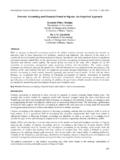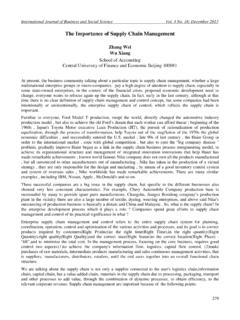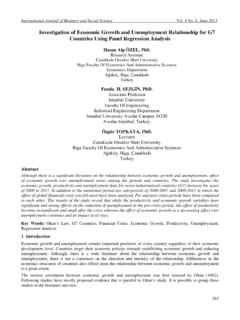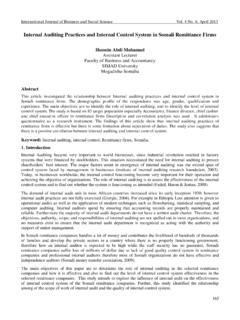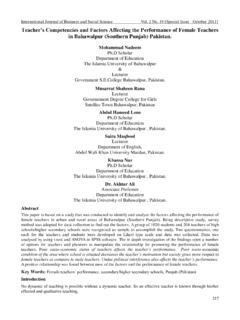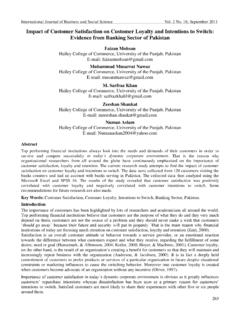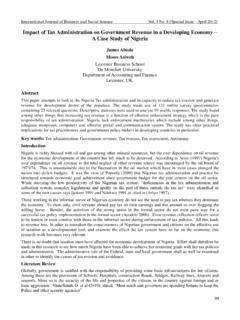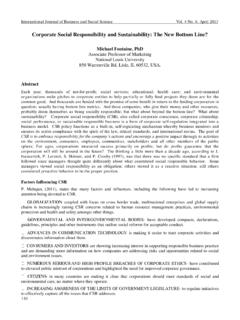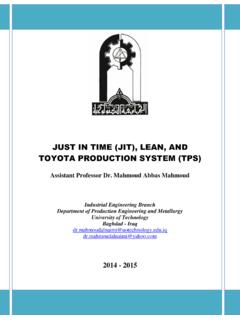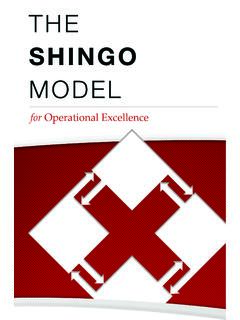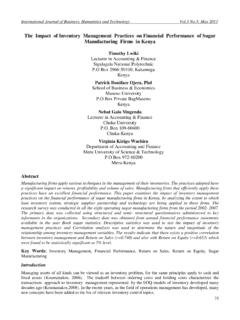Transcription of The Use of 5S in Healthcare Services: a Literature Review
1 International Journal of Business and Social Science Vol. 5, No. 10(1); September 2014 240 The Use of 5S in Healthcare services : a Literature Review Fanny Y. F. Young The Hong Kong Shue Yan University 10 WaiTsui Crescent Braemer Hill, North Point Hong Kong Abstract The aim of this paper is to Review the use of 5S in Healthcare services . The scholarly Literature up to June 2014 was searched through the Proquest, Pubmed and Google Scholar databases. Information about 5S, lean , ways to implement 5S in Healthcare settings, use of 5S in Healthcare , combinations of 5S and other tools and suggestions to enhance success of 5S in Healthcare services were reviewed. Results showed that 5S can be applied to Healthcare services with beneficial effects. Sustain is a key to success. Keywords: 5S, lean , Healthcare 1.
2 Introduction The costs of health care are increasing very rapidly, health care providers, clinics, hospitals, are under significant pressure to reduce costs despite more pressure to improve service and patient safety, reduce patient waiting times, and minimize errors and associated litigation. The total time from the beginning to the end of a patient process in hospitals, therapy settings and laboratories, and becomes a key measurement that needs to improve (Ahlstrom, n. d.). The Toyota manufacturing company has developed system principles to address similar issues in automobile manufacturing (Ikuma and Nahmens, 2014). In the early 1980s Takashi Osada formalized a framework of applying 5S within a business (Ho et. al., 1995). Ho (1999) described 5S as a five-phase technique to establish and maintain a quality environment in an organization.
3 5S stands for five words translated from Japanese, sort, straighten/set in order, shine/scrub, standardize, and sustain. The outcome of 5S is a well-organized workplace, where employees can easily distinguish common and uncommon conditions to ensure a reduction of defects and costs, and to maintain a safe work environment (Ikuma and Nahmens, 2014). The basic idea is to provide what is needed, at the time it is needed and where it is needed. 5S is one of the tools that within the set of Toyota management system principles termed lean thinking/philosophy (Womack and Jones, 1996). lean practitioners recognize that the 5S is the foundation of a lean facility (Summers, 2007). The original goal of 5S was to improve efficiency and product quality. After decades of development by automotive manufacturers, the implementation of lean , including 5S, resulted in improved productivity, quality and safety (Ohno, 1988).
4 Different health care institutes have adopted the 5S to improve efficiency and services . The aim of this article is to provide an updated account on the application and effect of 5S in Healthcare services by reviewing the Literature . 2. Materials and Methods The scholarly Literature up to June 2014 was searched through the Proquest, Pubmed and Google Scholar databases. In the medical database PubMed, using the search string 5S OR lean OR Toyota Production System ; in the business/management database Proquest, using 5S OR lean OR Toyota Production System and a collection of health/medical care terms ( , health care, medical care, hospital, clinic); and (3) the interdisciplinary database Google Scholar using health care OR medical care OR hospital OR clinic AND lean OR Toyota Production System OR 5S.
5 Finally, the references of retrieved articles were searched for other relevant articles. Books within the disciplines of Management and Healthcare were searched in the Hong Kong Shue Yan University library and the University of Hong Kong library in relation to the topic of 5S, lean , Toyota Production System. The uses and applications of 5S management applicable to Healthcare management were summarized. Center for Promoting Ideas, USA 241 3. Description of 5S 5S is a popular housekeeping management tool within the lean paradigm. 5S is intended for the physical work environment and is the simplest to implement for organizing, standardizing and maintaining the workplace (Kilpatrick, 2003). 5S stands for sort (seiri), straighten/set in order (seiton), shine/scrub (seiso), standardize (seiketsu), and sustain (shitsuke).
6 In Sort: Separate needed items from unneeded items by sorting through items and disposing of rarely used items using red tagging. In Straighten/Set in order: Arrange the remaining items to be most efficient and accessible following the process flow by organizing and labeling item locations. In Shine/Scrub: Maintain the work area for the already sorted and set in order items by cleaning the work area. In Standardize: Ensure consistency across all users by developing procedures to maintain and monitor the first three S s. In Sustain: Maintain and improve the outcome from sort, straighten/set in order, shine/scrub and standardize phase through the use of management audits to stay disciplined (Ikuma and Nahmens, 2014). 4. Description of lean lean is a term adopted from Toyota manufacturing (therefore also referred to as Toyota Production System) defining a philosophy that reduce waste in any form and seriously strives to eliminate defects.
7 Waste means any action that does not add value to the product. The lean process evaluates operations step by step to identify waste and inefficiency and then creates new solutions to improve operations, increase efficiency, and reduce expenses. lean manufacturing principles , are applied in the manufacturing environment, especially in the automotive industry. Two basic lean concepts are: the relentless elimination of waste through standardization of processes and the involvement of all employees in process improvement (Ohno, 1988, Liker, 2004). Another way of looking at lean is through the five lean principles (Womack & Jones, 1996). These are based on an underlying assumption that organisations are made up of processes, and through engaging with these five principles in a step-wise and sequential way organisations can work to add value, reduce waste and continuously improve ( kaizen ) in an ever-repeating process (Radnor et.)
8 Al., 2012). lean is not a program, a quick fix, a responsibility that can be delegated, nor a set of quality improvement tools. It is a cultural transformation that changes how an organization works. It is a journey, not a destination. Unlike specific programs, lean has no finish line. No one stays on the sidelines in the quest to discover how to improve the daily work. It requires new skills, new habits, and often a new attitude throughout the organization from senior management to front-line service providers. Creating a culture of lean is to create a continuous desire for improvement; there is no turning back (Toussaint and Berry, 2013). lean consultant Joan Wellman (2011) states, With lean , you will keep changing your definition of what good is. Radner and coworkers (2012) distinguished three aspects of the lean activities: assessment, improvement, and performance monitoring.
9 Assessment activities which include reviewing the performance of existing organizational processes in terms of their waste, flow or capacity to add value. Improvement activities to support and improve processes, Rapid Improvement Events ( kaizen blitz or kaikaku ) which are held over several days and involve staff evaluating, developing and redesigning processes through forms of problem solving or housekeeping tools, such as 5S . Finally, monitoring to measure the processes and any improvements made, which include visual management tools that feature highly visible information on process flows, standard operating procedures and performance data. In a lean organization, everyone is responsible and accountable for integrating lean thinking principles , methodologies, and tools into daily work. In the health care perspective, it is simply providing the best value from the patient s perspective, while using the talents of the people in the system and the fewest resources (Fairbanks, 2007).
10 Fairbanks (2007) identified eight wastes in any organization: unused human potential, waiting, inventory, transportation, defects, motion, overproduction, and processing. This paper will focus on the lean that included 5S. 5. Ways to Implement 5S in Healthcare Settings When implementing 5S, staff should not focus on getting organized. Rather, they need to consider how they deal with all the things that come to them and what is within their environment; this will help in creating a 5S workplace (Ahlstrom, ). International Journal of Business and Social Science Vol. 5, No. 10(1); September 2014 242 For example, doctors do not focus on getting their operating room organized. Instead, they have a defined process for preparing for an operation: they wash their hands in a certain way; the instruments used are predefined and laid out in a specific way.
